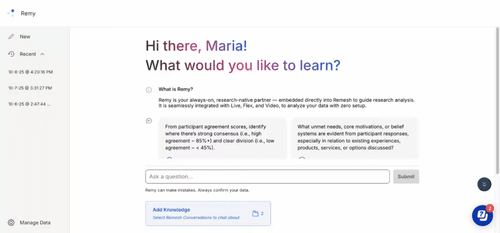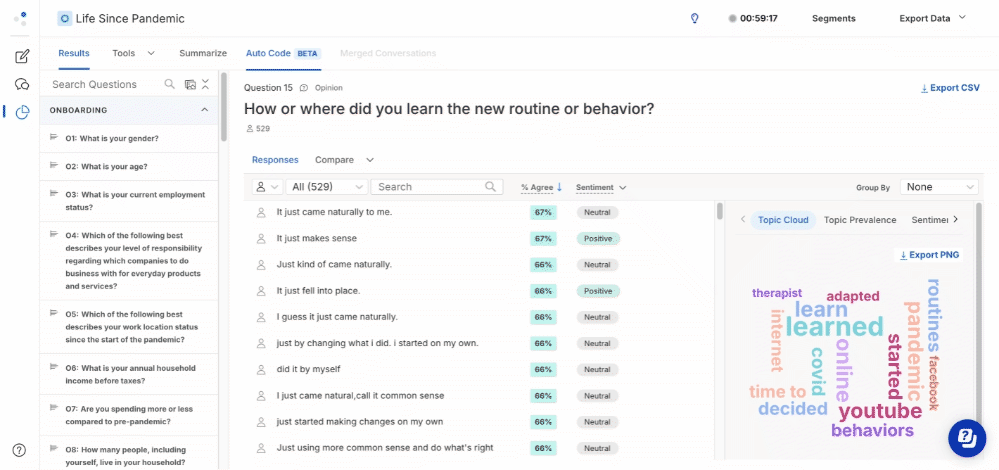Analysis Tools Overview
This article is relevant to our Live and Flex Conversations. You can find more information about our product offerings here. For more information about Video analysis, please reference this document.
Overview
There is no single, “right way” of analyzing data in Remesh. How you prepare and analyze the data will ultimately vary depending on the study, overall objectives, and your personal preferences as a researcher.
Remesh has a number of analysis tools available that help make your analysis easy. In this article, we’ll be focusing specifically on Post Conversation Analysis resources, indicated by this icon ![]() . These are the tools that become available after your Remesh Conversation has ended or after you’ve imported your external data.
. These are the tools that become available after your Remesh Conversation has ended or after you’ve imported your external data.
Some of our analysis tools require that a Workspace Admin enable Large Language Model features. You can read more about LLM feature enablement here, and will find a note alongside the features that require enablement.
Included in this Article
- Getting Started
- Remy
- Results
- Thematic Clusters
- Summarize
- AutoCode
- Sentiment
- Search Topics
- Common Topics Tab
- Starred Responses
- Topline PowerPoint
- Collections
- Video
Getting Started
Before you begin your analysis, it can be helpful to review the following.
- Segments are the easiest way to cut data throughout your analysis. We recommend creating a few segments before you begin your analysis for easy access, but you can continue to create them throughout as well.
- We have a few metrics that are unique to Remesh, the primary one being our Percent Agree metric. This metric is specific to our Ask Opinion questions, and leverages an algorithm to generate a projected percentage of the population that would agree with a given response. You can read more about all our metrics here!
- If you are more of a visual learner, our quick start videos might be a helpful place to start!
Conducting Employee Research? Check out our webinar recap with one of our in house researchers discussing how they recommend turning employee insights into action with Remesh.
👉 Turning Employee Engagement Insights into Action with Remesh
Remy
This features utilizes Generative AI, you can read more here.

| What it is | When To Use It | In Action |
| Remy is your AI Agent embedded directly into Remesh and designed to serve as a partner to researchers in their Remesh research journey. | We recommend using Auto Code when you would like see multiple themes that each open end response is related to. | Ask Remy to draft a Stop/Start/Continue plan using your data you've collected, citing evidence for each aspect of the plan. |
Want to learn more about Remy? Click here!
Results

| What it is | When To Use It | In Action |
| A question by question deep dive into your qualitative and quantitative data. Use segments to filter your data, create visuals and download exports. | Results is best for taking a deeper look at your qualitative and quantitative data and for creating visuals. | When you're ready to begin building your report, create and customize visuals then export them to input into your desired format. |
Thematic Clusters
Found within the Results tab

| What it is | When To Use It | In Action |
| Automatically organizes open end question responses into themes. Users can adjust the number of themes but each response will only appear once. | Use Thematic Clusters if you are hoping to identify distinct themes for each question. | Particularly useful in exploratory research, you can quickly uncover themes for a question that you may not have been aware of. |
Summarize
This features utilizes Generative AI, you can read more here.

| What it is | When To Use It | In Action |
| Automatically generated summaries of responses. This will provide a Conversation-level Summary as well as each individual question. | We recommend using Summarize as a first step after you end your Conversation, allowing you to get a broader understanding of what data you’ve collected before diving deeper. | Copy your Conversation- summary, make any necessary edits and send it to key stakeholders as a follow up. Then take a look at Auto Code and Results for further investigation on a question by question level. |
Want to learn more about Summarize? Click here!
Auto Code
This features utilizes Generative AI, you can read more here.

| What it is | When To Use It | In Action |
| We take the first attempt at the qualitative research process of coding open end responses. Each response is typically associated with 1-5 codes. | We recommend using Auto Code when you would like see multiple themes that each open end response is related to. | Select codes to sort responses and make edits to codes as you continue to identify themes. Make note of how these themes relate to your research question, and begin crafting a narrative response to that question. |
Want to learn more about Auto Code? Click here!
Sentiment
Found within Results and Auto Code tabs
| What it is | When To Use It | In Action |
| Automatically assigns a positive, negative of neutral sentiment tag to each open end response, which you can manually adjust if needed. | Use sentiment analysis if you’d like to get a feel for how your audience was feeling towards a given topic. | Sort a question by sentiment to quickly see how a group is feeling, then target a specific sentiment label to pull responses for your reporting. |
Want to learn more about Sentiment? Click here!
Search Topics

| What it is | When To Use It | In Action |
| Search Topics enables you to analyze and understand key words (Common Topics) at the Conversation-level. This allows you to go beyond a question-by-question framework to tell a big-picture story using responses from every open-ended question in your Conversation. | Use Search Topics easily see what Common Topics appeared most frequently in responses and search for additional Common Topics to create a custom visual. | Select Common Topics and sort by segment to create a custom visual. Export the visual and include it in your report. |
Want to learn more about Searc Topics? Click here!
Common Topics Tab
-gif.gif?width=500&height=235&name=common%20topics%20(1)-gif.gif)
| What it is | When To Use It | In Action |
| Common Topics is a tab that contains keywords that appeared most often in responses throughout the Conversation. | Use the Common Topics Tab to sort responses based upon keywords, and build Collections based upon theme or responses to be used for reporting. | Select Common Topics of interest, read through responses and create a Collection of responses you'd like to use in your report. |
Common Topics is also the term we use for any keywords that show up most frequently in open end responses. Results, Common Topics and Search Topics all contain Common Topics. Results contains Common Topics on a question by question basis, while the Common Topics and Search Topics tabs contain Conversation level Common Topics. Read more about the Common Topics metric and how to use it here!
Starred Responses

| What it is | When To Use It | In Action |
| Starred responses are responses to Ask Opinion questions that either a moderator or observer marked while a Conversation was gathering data. | Use starred responses to identify responses that are most valuable to stakeholders. | Bring starred responses into your report to incorporate aspects of the Conversation that resonated most with stakeholders. |
Topline PowerPoint

| What it is | When To Use It | In Action |
| An automatically generated PowerPoint that creates 1-2 slides for each question. | We recommend using this export as a base if you will be creating a report. You can then customize it with your own branding and additional visuals from the Results tab! | Export the Topline PowerPoint and use it a space to take notes as you are analyzing. Then, begin customizing it to build your custom report including word clouds and graphs from the Results tab! |
Want to learn more about the Topline PowerPoint? Click here!
Collections
Found within all items in the "Tools" drop down.

| What it is | When To Use It | In Action |
| A way to create collections of open end responses to aid in your reporting. | Use collections if you would like to create customize groupings of participant responses as you analyze. | Create a Collection as you are analyzing, then come back to it over time to pull key responses for your reporting. |
Want to learn more about Collections? Click here!
Video
If you're planning on conducting research using Remesh Video, we recommend referencing the this guide that is specific to Video analysis tools.